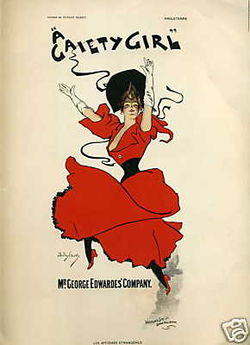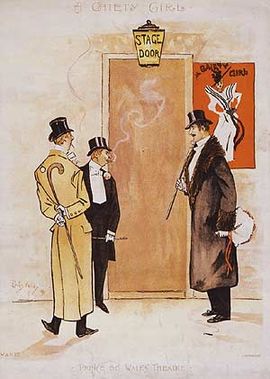
Gaiety Girls
Encyclopedia

Gaiety Girls were the chorus girls in Edwardian musical comedies, beginning in the 1890s at the Gaiety Theatre, London
Gaiety Theatre, London
The Gaiety Theatre, London was a West End theatre in London, located on Aldwych at the eastern end of the Strand. The theatre was established as the Strand Musick Hall , in 1864 on the former site of the Lyceum Theatre. It was rebuilt several times, but closed from the beginning of World War II...
, in the shows produced by George Edwardes
George Edwardes
George Joseph Edwardes was an English theatre manager of Irish ancestry who brought a new era in musical theatre to the British stage and beyond....
. The popularity of this genre of musical theatre
Musical theatre
Musical theatre is a form of theatre combining songs, spoken dialogue, acting, and dance. The emotional content of the piece – humor, pathos, love, anger – as well as the story itself, is communicated through the words, music, movement and technical aspects of the entertainment as an...
depended, in part, on the beautiful dancing corps of "Gaiety Girls" appearing onstage in bathing attire and in the latest fashions. The 1890s Gaiety Girls were respectable, elegant young ladies, unlike the corseted actresses from London's earlier musical burlesques. Later, even the stars of these musical comedies were referred to as Gaiety Girls.
Fashion icons
An American newspaper reviewing A Gaiety GirlA Gaiety Girl
A Gaiety Girl is an English musical comedy in two acts by a team of musical comedy neophytes: Owen Hall , Harry Greenbank and Sidney Jones . It opened at Prince of Wales Theatre in London, produced by George Edwardes, on 14 October 1893 and ran for 413 performances. The show starred C...
in 1894 explained the importance of the Gaiety Girls: "The piece is a mixture of pretty girls, English humor, singing, dancing and bathing machines and dresses of the English fashion. The dancing is a special feature of the performance, English burlesques giving much more attention to that feature of their attractiveness than the American entertainments of the same grade do." Many of the best-known London couturiers designed costumes for stage productions by the 1890s. The illustrated periodicals were eager to publish photographs of the actresses in the latest stage hits, and so the theatre became an excellent way for clothiers to publicise their latest fashions.

Strand, London
Strand is a street in the City of Westminster, London, England. The street is just over three-quarters of a mile long. It currently starts at Trafalgar Square and runs east to join Fleet Street at Temple Bar, which marks the boundary of the City of London at this point, though its historical length...
, for his girls to dine there at half-price. It was good exposure for the girls and made Romano's the centre of London's night-life. Many of the Gaiety Girls, such as Marie Studholme
Marie Studholme
Marie Studholme , born Caroline Maria Lupton or Marion Lupton, was an English actress and singer known for her supporting and sometimes starring roles in Victorian and Edwardian musical comedy...
, Ellaline Terriss
Ellaline Terriss
Ellaline Terriss, born Ellaline Lewin , was a popular English actress and singer, best known for her performances in Edwardian musical comedies...
, Lily Elsie
Lily Elsie
Lily Elsie was a popular English actress and singer during the Edwardian era, best known for her starring role in the hit London premiere of Franz Lehár's operetta The Merry Widow....
, Cicely Courtneidge
Cicely Courtneidge
Dame Esmerelda Cicely Courtneidge DBE was an English actress and comedienne. The daughter of the producer Robert Courtneidge, she was appearing in his productions in the West End, by the age of 16, and was quickly promoted from minor to major roles in his Edwardian musical comedies.After the...
, Jessie Matthews
Jessie Matthews
Jessie Matthews, OBE was an English actress, dancer and singer of the 1930s, whose career continued into the post-war period.-Early life:...
, Gladys Cooper
Gladys Cooper
Dame Gladys Constance Cooper, DBE was an English actress whose career spanned seven decades on stage, in films and on television....
, Phyllis Dare
Phyllis Dare
Phyllis Dare born Phyllis Constance Haddie Dones was an English singer and actress who was famous for her performances in Edwardian musical comedy and other musical theatre in the first half of the 20th century....
, Zena Dare
Zena Dare
Zena Dare was an English singer and actress who was famous for her performances in Edwardian musical comedy and other musical theatre and comedic plays in the first half of the 20th century, and for her role as Mrs...
, Mabel Love
Mabel Love
Mabel Love , was a British dancer and stage actress. She was considered to be one of the great stage beauties of her age, and her career spanned the late Victorian era and Edwardian period...
, Evelyn Laye
Evelyn Laye
Evelyn Laye, CBE was an English theatre and film actress.-Early years and career:Born as Elsie Evelyn Lay in Bloomsbury, London, Laye made her first stage appearance in August 1915 at the Theatre Royal, Brighton as Nang-Ping in Mr...
, Gaby Deslys
Gaby Deslys
Gaby Deslys was a dancer, singer, and actress of the early 20th century from Marseilles, France. She selected her name for her stage career. It is an abbreviation of Gabrielle of the Lillies. During the 1910s she was exceedingly popular worldwide, making $4,000 a week in the United States alone...
, Camille Clifford
Camille Clifford
Camilla Antoinette Clifford was a Belgian-born stage actress and the most famous model for the "Gibson Girl" illustrations. Her towering coiffure and hourglass figure defined the Gibson Girl style....
, Gabrielle Ray
Gabrielle Ray
Gabrielle Ray , was an English stage actress, dancer and singer, best known for her roles in Edwardian musical comedies....
, Sylvia Grey
Sylvia Grey
Sylvia Grey was an English actress and dancer best remembered for her roles in burlesque productions in London during the Victorian era.-Life and career:...
and Constance Collier
Constance Collier
Constance Collier was an English film actress and acting coach.-Life and career:Born Laura Constance Hardie, in Windsor, Berkshire, Collier made her stage debut at the age of 3, when she played Fairy Peasblossom in A Midsummer's Night Dream...
, enjoyed very substantial acting careers. One Gaiety Girl, Mabel Russell, became a Member of Parliament
Member of Parliament
A Member of Parliament is a representative of the voters to a :parliament. In many countries with bicameral parliaments, the term applies specifically to members of the lower house, as upper houses often have a different title, such as senate, and thus also have different titles for its members,...
.
Stagedoor Johnnies; marriage into the upper class

The Beauty of Bath
The Beauty of Bath is a musical comedy with a book by Seymour Hicks and Cosmo Hamilton, lyrics by C. H. Taylor and music by Herbert Haines; additional songs were provided by Jerome Kern , F. Clifford Harris and P. G. Wodehouse . The story concerns a young woman from a noble family, who falls in...
, married a nobleman, Baron Von Ditton, of Norway. Similarly, Sylvia Lillian Storey (1890-1947) another chorister in the same show, married William John Lydson, Earl Poulett. Gertie Millar
Gertie Millar
Gertrude "Gertie" Millar was one of the most famous English singer-actresses of the early 20th century, known for her performances in Edwardian musical comedies....
became the Countess of Dudley, and Olive May married into the peerage twice. First, she became Lady Victor Paget (marrying in 1913 and divorcing in 1921) and then the Countess of Drogheda (marrying the 10th Earl in 1922). The potential for such relationships was an underlying theme of many of the stories of P. G. Wodehouse
P. G. Wodehouse
Sir Pelham Grenville Wodehouse, KBE was an English humorist, whose body of work includes novels, short stories, plays, poems, song lyrics, and numerous pieces of journalism. He enjoyed enormous popular success during a career that lasted more than seventy years and his many writings continue to be...
, particularly those set at Blandings Castle
Blandings Castle
Blandings Castle is a recurring fictional location in the stories of British comic writer P. G. Wodehouse, being the seat of Lord Emsworth , home to many of his family, and setting for numerous tales and adventures, written between 1915 and 1975.The series of stories which take place at the castle,...
.
Alan Hyman
Alan Hyman (writer)
Alan Maurice Hyman was an English author, journalist and film writer.Hyman was the son of A Hyman, and was educated at St Cyprian's School, Repton School and Magdalene College, Cambridge. He became a journalist and worked on the staff of the Daily Sketch and Sunday Graphic from 1929 to 1932...
, an expert on burlesque theatre who penned the 1972 book The Gaiety Years, wrote:
At the old Gaiety in the Strand the chorus was becoming a matrimonial agency for girls with ambitions to marry into the peerage and began in the nineties when Connie Gilchrist, a star of the Old Gaiety, married the 7th Earl of Orkney and then in 1901, the 4th Marquess of HeadfortGeoffrey Taylour, 4th Marquess of HeadfortGeoffrey Thomas Taylour, 4th Marquess of Headfort DL, JP, FZS , styled Lord Geoffrey Taylour until 1893 and Earl of Bective between 1893 and 1894, was a British politician and Army officer....
married Rosie Boote, who had charmed London the previous year when she sang Maisie in The Messenger BoyThe Messenger BoyThe Messenger Boy is a musical comedy in two acts by James T. Tanner and Alfred Murray, lyrics by Adrian Ross and Percy Greenbank, with music by Ivan Caryll and Lionel Monckton, with additional numbers by Paul Rubens. The story concerned a rascally financier who tries to discredit a rival in love...
. After Connie Gilchrist and Rosie Boote had started the fashion a score of the Guv'nor'sGeorge EdwardesGeorge Joseph Edwardes was an English theatre manager of Irish ancestry who brought a new era in musical theatre to the British stage and beyond....
budding stars left him to marry peers or men of title while other Gaiety Girls settled for a banker or a stockbroker. The Guv’nor finding this was playing ducks and drakes with his theatrical plans had a 'nuptial clause' inserted in every contract.... Debutantes were competing with the other girls to get into the Gaiety chorus while upper-class youths were joining the ranks of the chorus boys.

